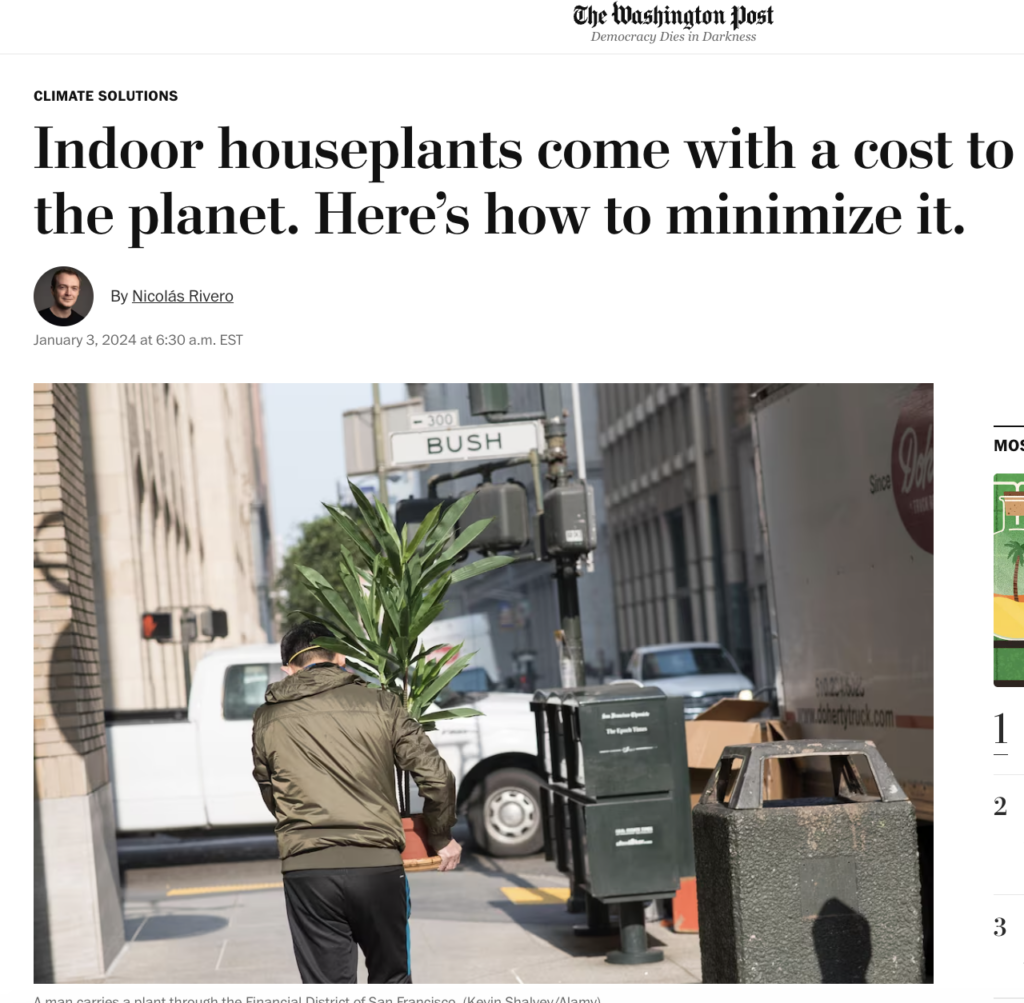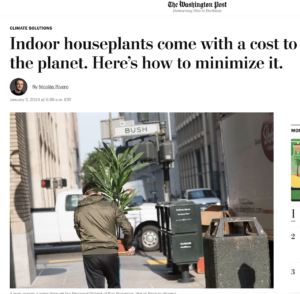https://www.washingtonpost.com/climate-solutions/2024/01/03/sustainable-houseplant-care/
That doesn’t mean you shouldn’t grow potted plants, according to Susan Pell, the director of the U.S. Botanic Garden in Washington, D.C. But she has a few tips for minimizing the environmental harm of indoor gardening.
“Every little thing we do adds up collectively, so if all of us are doing these things, the collective impact is quite large,” she said. Plus, “the mindful act of trying to be more sustainable in one area of your daily life … helps you to be mindful in other areas.”
Before you order a trendy plant you spotted in an Instagram ad or even take a trip to your local nursery, take a moment to think about where those plants come from.
“A lot of major nursery suppliers are located in Florida and in California,” Pell said. Depending on where you live, that can be a long way for a plant to travel in the back of a truck — and a lot of carbon emitted along the way.
To save some money and carbon emissions, Pell suggests looking for local plant swaps or garden clubs in your area, which are often organized online or on social media sites. Other gardeners are often happy to give you cuttings of their own plants, which you can propagate and grow into plants of your own.
“Those groups frequently meet multiple times a year and they share not just plant cuttings and potted plants with each other, but they’ll share knowledge as well and sometimes have community events,” Pell said.
Pell encourages gardeners to buy pots, shears, trowels, plant stands and other tools locally and think about durability.
“I love to buy plant stands from antique stores,” she said. “You can often find locally made ceramic pots throughout the country and certainly in our area” near D.C.
Pell recommends terracotta and ceramic pots that will last, rather than the cheap, black plastic pots that quickly fall apart. (If you want a disposable pot, Pell recommends getting one made from biodegradable materials.) If one of your plastic pots breaks, check to see whether your local government recycles them. If not, you can often drop them off for recycling at a plant nursery.
One of the least sustainable soil components is peat, a rich brown substance formed from partially decayed plant matter at the bottom of bogs and other wetlands. Gardening guides recommend using peat as part of the soil mix for many plants because it retains water and adds structure to the soil.
Pell recommends trying out peat alternatives, like coconut coir or biochar, which also retain water in soil mix with less of the environmental baggage. Your local nursery or garden center may sell peat-free potting mix.
Pell also recommends cutting down on petroleum-based fertilizers, which create carbon emissions during their production. You can look for organic fertilizers or mix compost from your kitchen into your soil mix as an alternative.
“I myself almost never fertilize my houseplants, and they do just fine,” she said.
…
#
876

Washinton Post: “Greening indoor spaces can also come at an environmental cost. The trucks that transport plants spew carbon emissions, plastic pots, and synthetic fertilizers are made from petroleum and the harvesting of soil components like peat can tear up slow-forming habitats. …
“A lot of major nursery suppliers are located in Florida and in California,” Susan Pell, the director of the U.S. Botanic Garden in Washington, D.C., said. Depending on where you live, that can be a long way for a plant to travel in the back of a truck — and a lot of carbon emitted along the way.
Pell has a few tips for minimizing the environmental harm of indoor gardening…also recommends cutting down on petroleum-based fertilizers, which create carbon emissions during their production.




